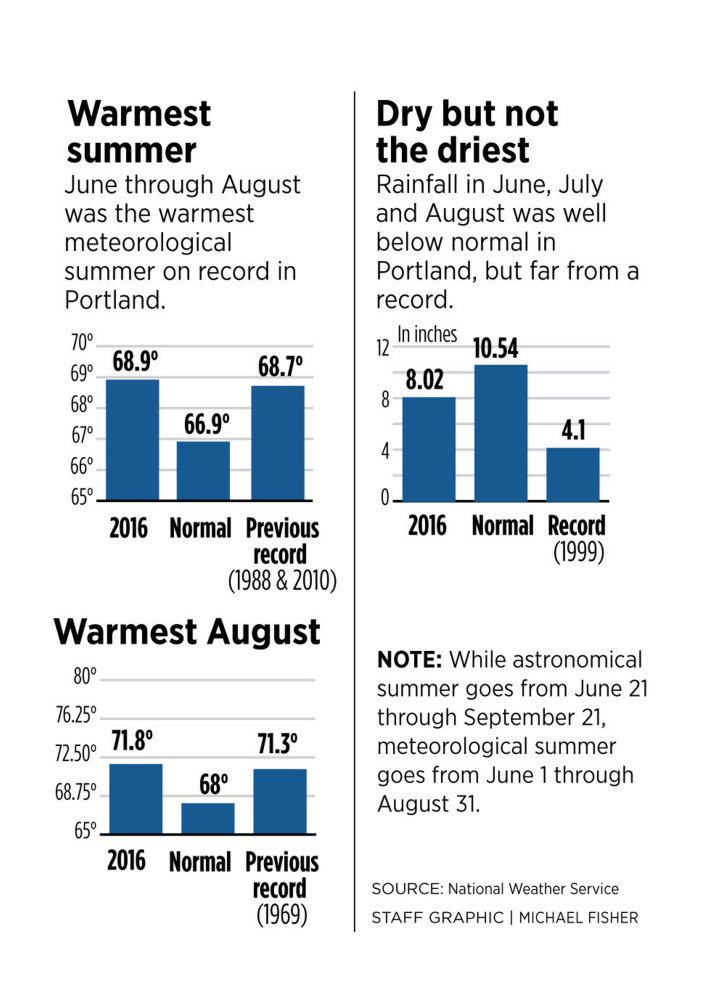The unofficial summer that ended this week was the warmest in Portland since record keeping began here 75 years ago.
June, July and August weren’t extremely hot – there was no string of three or more 90-plus degree days.
But the average temperature was 68.9 degrees – 2 degrees above normal and slightly higher than the previous record of 68.7 degrees that was recorded in 2010 and 1988. While the astronomical summer doesn’t end until Sept. 22, June through August is the meteorological season for weather comparisons.
Temperatures in Portland exceeded 90 degrees on seven days during the summer, including on Aug. 12, when Portland hit a summer high of 99. The normal for a summer is about four days with 90-plus degree highs, although the record is 15, set in 1955.
“We didn’t necessarily see a lot of hot days,” said Chris Kimble, meteorologist at the National Weather Service office in Gray. “But what we saw was a lot of days that were warmer than normal, and it was consistently warmer than normal.”
The summer also was unusually dry, challenging both farmers and backyard gardeners, but not dry enough to set any records. Portland recorded 8.02 inches of rain in the past three months – 2.52 inches below normal. The driest summer on record was 1999, when just 4.1 inches of rain fell on Portland.
Portland shares its weather superlatives with many communities across the globe. It was the hottest summer ever recorded in Detroit, the hottest August and the driest summer in Boston, and July was the hottest month ever recorded on Earth since scientists started tracking temperatures in 1880.
The warm and dry summer drew locals and visitors alike to places like Portland Head Light in Cape Elizabeth, the Casco Bay Lines ferry service in Portland and public parks throughout Maine.
“The weather conditions this summer were great for our state parks,” said John Bott, spokesman for the Maine Department of Agriculture, Conservation and Forestry. “Our attendance is up 20 percent over last year, which was a record-setting year.”
Year-to-date attendance counts increased from 1.3 million visitors through July 2015 to 1.6 million visitors through July 2016, and Bott said he expects the 20 percent growth to hold when August attendance numbers are factored in.
While all three summer months were warmer than normal, August was especially toasty and was the warmest August on record, according to the weather service. The average temperature for Portland last month was 71.8, or 3.8 degrees above normal. The previous record was 71.3, set in 1969.
Kimble said warm and dry air was the result of the jet stream staying farther to the north, keeping cooler air out, and a lack of coastal storms.
“If you have a jet stream that’s moved to the north, you have hot and dry weather, normally,” he said. “Also, we haven’t had the coastal storms. That’s where we get a lot of our heavy precipitation and that tends to bring cooler temperatures.”
The warm, dry summer wasn’t particularly kind to farmers, especially in southern and central Maine, where abnormally dry to moderate drought conditions are being reported by the U.S. Department of Agriculture. Bott’s department is participating in a survey of Maine farmers to find out how they’ve been affected by the shortage of rain in many parts of Maine.
“It’s been beautiful to go to the beach or the lake, but it’s been hard on us,” said Caitlin Jordan, manager of Alewive’s Brook Farm in Cape Elizabeth.
Jordan and the rest of her family cultivate 20 acres of tomatoes, cucumbers, squash and other produce off Route 77, and they usually irrigate with water from the brook. But it’s been bone dry all season, so they’ve only been able to water about one acre with a drip line.
“It’s been so warm and dry, some things are growing faster than they should, and other things aren’t growing fast enough,” Jordan said. “Every time rain was predicted, it missed us.”
Still, Jordan said, it’s been decent growing season at the farm, and there’s more than a month left to go. They recently planted broccoli, cauliflower, lettuce and beets that will be harvested into autumn.
“You cross your fingers and hope you have a long, warm fall and don’t have an early frost,” Jordan said.
Send questions/comments to the editors.



